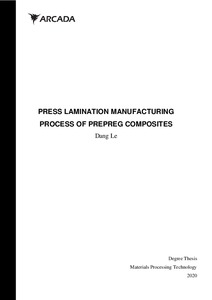Press Lamination Manufacturing Process of Prepreg Composites
Le, Dang (2020)
Le, Dang
2020
All rights reserved. This publication is copyrighted. You may download, display and print it for Your own personal use. Commercial use is prohibited.
Julkaisun pysyvä osoite on
https://urn.fi/URN:NBN:fi:amk-2020121427942
https://urn.fi/URN:NBN:fi:amk-2020121427942
Tiivistelmä
Prepregs are products of combining a modified resin system with a preform of
reinforcement textiles to obtain the desired properties. This thesis studies the main
principle of making prepreg, the industrial processes that manufacturers use, and how to apply that process on a smaller scale for the Arcada lab room.
The author did research on the two most commonly used groups of processes: hot-melt and solvent coating processes. The result shows the importance of precise control of the resin content of the uncured prepreg because it ensures the right amount of resin to fill out all the internal areas of the textile. The initial amount of resin and the excess resin to be removed have to be calculated beforehand. The change in the amount of resin inside the system leads to a change in the total thickness of the prepreg. Research has shown
that, by controlling that change in thickness of the prepreg, we can ensure that the exact
amount of excess resin can flow out without causing fiber distortion and voids creation.
Next, the author had to test out different combinations of glass fiber, Jute, and carbon fiber and resin systems by hand laminating. The result showed mismatches between the textile structure and the resin viscosity, with the additional effects of surface tension,
flow speed, or the use of additives. Higher density textiles behave better with pressure, while lower-density one's exhibit flaws like porosity and yawn displacements.
A small scale prepreg machine was then designed based on controlling the resin content to deal with the problems of voids and incomplete wetting. It can be made by assembling laser cut parts while a set of screws while controlling the height of the
working surface. The machine is compact, easy to assemble, and can be maintained or upgraded by other students. This can provide better control of quality for the prepregs made in the Arcada lab. The main downside is that the machine and the prepregs made
by hand impregnation cannot be tested for physical properties due to the Covid-19 pandemic.
reinforcement textiles to obtain the desired properties. This thesis studies the main
principle of making prepreg, the industrial processes that manufacturers use, and how to apply that process on a smaller scale for the Arcada lab room.
The author did research on the two most commonly used groups of processes: hot-melt and solvent coating processes. The result shows the importance of precise control of the resin content of the uncured prepreg because it ensures the right amount of resin to fill out all the internal areas of the textile. The initial amount of resin and the excess resin to be removed have to be calculated beforehand. The change in the amount of resin inside the system leads to a change in the total thickness of the prepreg. Research has shown
that, by controlling that change in thickness of the prepreg, we can ensure that the exact
amount of excess resin can flow out without causing fiber distortion and voids creation.
Next, the author had to test out different combinations of glass fiber, Jute, and carbon fiber and resin systems by hand laminating. The result showed mismatches between the textile structure and the resin viscosity, with the additional effects of surface tension,
flow speed, or the use of additives. Higher density textiles behave better with pressure, while lower-density one's exhibit flaws like porosity and yawn displacements.
A small scale prepreg machine was then designed based on controlling the resin content to deal with the problems of voids and incomplete wetting. It can be made by assembling laser cut parts while a set of screws while controlling the height of the
working surface. The machine is compact, easy to assemble, and can be maintained or upgraded by other students. This can provide better control of quality for the prepregs made in the Arcada lab. The main downside is that the machine and the prepregs made
by hand impregnation cannot be tested for physical properties due to the Covid-19 pandemic.
